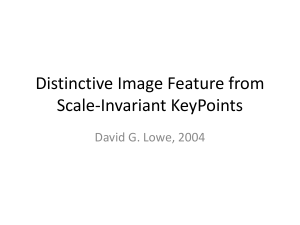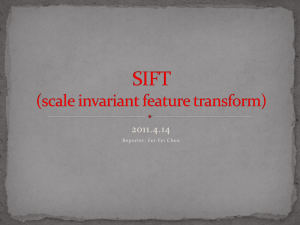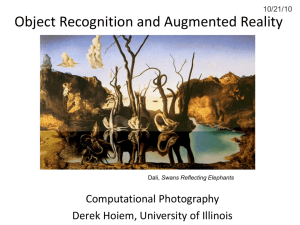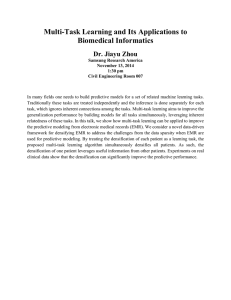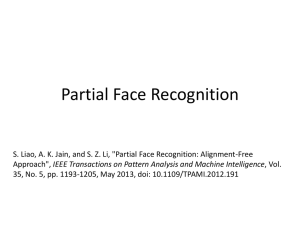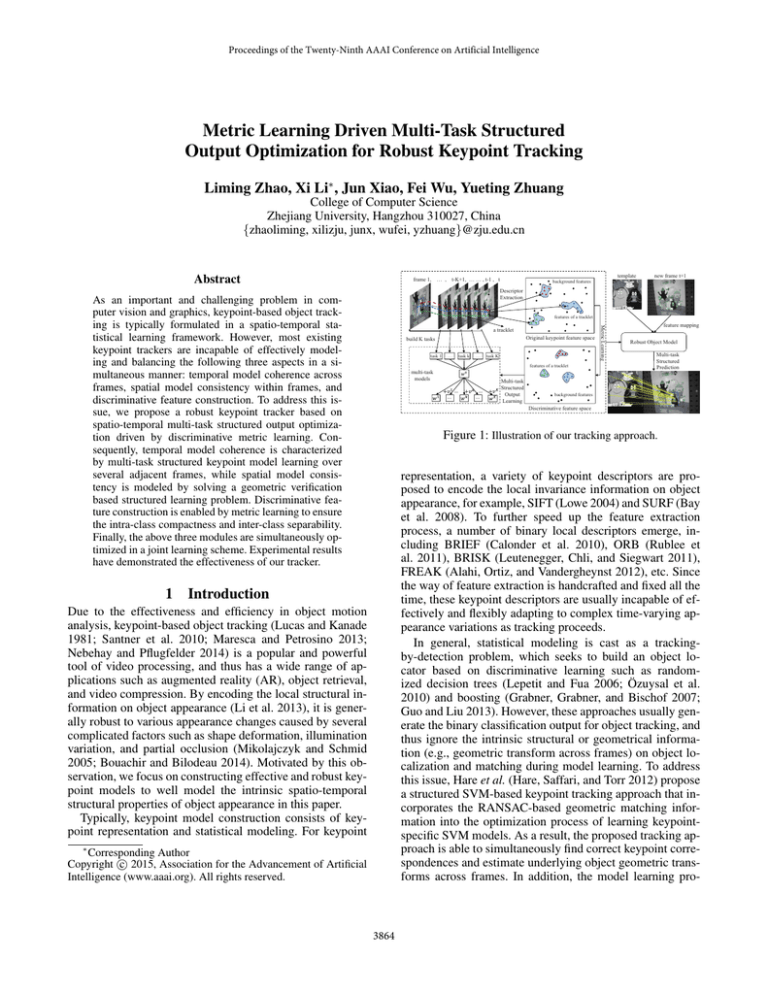
Proceedings of the Twenty-Ninth AAAI Conference on Artificial Intelligence
Metric Learning Driven Multi-Task Structured
Output Optimization for Robust Keypoint Tracking
Liming Zhao, Xi Li∗ , Jun Xiao, Fei Wu, Yueting Zhuang
College of Computer Science
Zhejiang University, Hangzhou 310027, China
{zhaoliming, xilizju, junx, wufei, yzhuang}@zju.edu.cn
Abstract
new frame t+1
background features
Descriptor
Extraction
As an important and challenging problem in computer vision and graphics, keypoint-based object tracking is typically formulated in a spatio-temporal statistical learning framework. However, most existing
keypoint trackers are incapable of effectively modeling and balancing the following three aspects in a simultaneous manner: temporal model coherence across
frames, spatial model consistency within frames, and
discriminative feature construction. To address this issue, we propose a robust keypoint tracker based on
spatio-temporal multi-task structured output optimization driven by discriminative metric learning. Consequently, temporal model coherence is characterized
by multi-task structured keypoint model learning over
several adjacent frames, while spatial model consistency is modeled by solving a geometric verification
based structured learning problem. Discriminative feature construction is enabled by metric learning to ensure
the intra-class compactness and inter-class separability.
Finally, the above three modules are simultaneously optimized in a joint learning scheme. Experimental results
have demonstrated the effectiveness of our tracker.
features of a tracklet
a tracklet
Original keypoint feature space
build K tasks
task 1
…
task k
…
task K
features of a tracklet
multi-task
models
…
...
…
...
Multi-task
Structured
Output
Learning
Metric Learning
1
template
frame 1, … , t-K+1, … … , t-1 , t
feature mapping
Robust Object Model
Multi-task
Structured
Prediction
background features
Discriminative feature space
Figure 1: Illustration of our tracking approach.
representation, a variety of keypoint descriptors are proposed to encode the local invariance information on object
appearance, for example, SIFT (Lowe 2004) and SURF (Bay
et al. 2008). To further speed up the feature extraction
process, a number of binary local descriptors emerge, including BRIEF (Calonder et al. 2010), ORB (Rublee et
al. 2011), BRISK (Leutenegger, Chli, and Siegwart 2011),
FREAK (Alahi, Ortiz, and Vandergheynst 2012), etc. Since
the way of feature extraction is handcrafted and fixed all the
time, these keypoint descriptors are usually incapable of effectively and flexibly adapting to complex time-varying appearance variations as tracking proceeds.
In general, statistical modeling is cast as a trackingby-detection problem, which seeks to build an object locator based on discriminative learning such as randomized decision trees (Lepetit and Fua 2006; Özuysal et al.
2010) and boosting (Grabner, Grabner, and Bischof 2007;
Guo and Liu 2013). However, these approaches usually generate the binary classification output for object tracking, and
thus ignore the intrinsic structural or geometrical information (e.g., geometric transform across frames) on object localization and matching during model learning. To address
this issue, Hare et al. (Hare, Saffari, and Torr 2012) propose
a structured SVM-based keypoint tracking approach that incorporates the RANSAC-based geometric matching information into the optimization process of learning keypointspecific SVM models. As a result, the proposed tracking approach is able to simultaneously find correct keypoint correspondences and estimate underlying object geometric transforms across frames. In addition, the model learning pro-
Introduction
Due to the effectiveness and efficiency in object motion
analysis, keypoint-based object tracking (Lucas and Kanade
1981; Santner et al. 2010; Maresca and Petrosino 2013;
Nebehay and Pflugfelder 2014) is a popular and powerful
tool of video processing, and thus has a wide range of applications such as augmented reality (AR), object retrieval,
and video compression. By encoding the local structural information on object appearance (Li et al. 2013), it is generally robust to various appearance changes caused by several
complicated factors such as shape deformation, illumination
variation, and partial occlusion (Mikolajczyk and Schmid
2005; Bouachir and Bilodeau 2014). Motivated by this observation, we focus on constructing effective and robust keypoint models to well model the intrinsic spatio-temporal
structural properties of object appearance in this paper.
Typically, keypoint model construction consists of keypoint representation and statistical modeling. For keypoint
∗
Corresponding Author
c 2015, Association for the Advancement of Artificial
Copyright Intelligence (www.aaai.org). All rights reserved.
3864
2.1
cess is independently carried out frame by frame, and hence
ignores the intrinsic cross-frame interaction information on
temporal model coherence, leading to instable tracking results in complicated scenarios.
In this work, we propose a joint learning approach that
is capable of well balancing the following three important parts: temporal model coherence across frames, spatial
model consistency within frames, and discriminative feature
construction. As illustrated in Figure 1, the joint learning
approach ensures the temporal model coherence by building a multi-task structured model learning scheme, which
encodes the cross-frame interaction information by simultaneously optimizing a set of mutually correlated learning
subtasks (i.e., a common model plus different biases) over
several successive frames. As a result, the interaction information induced by multi-task learning can guide the tracker
to produce stable tracking results. Moreover, the proposed
approach explores the keypoint-specific structural information on spatial model consistency by performing geometric
verification based structured output learning, which aims to
estimate a geometric transformation while associating crossframe keypoints. In order to make the keypoint descriptors
well adapt to time-varying tracking situations, the proposed
approach naturally embeds metric learning to the structured
SVM learning process, which enhances the discriminative
power of inter-class separability.
In summary, we propose a keypoint tracking approach
that learns an effective and robust keypoint model through
metric learning-driven multi-task structured output optimization. The main contributions of this work are as follows:
Let the template image O be represented as a set of keyO
points O = {(ui , qi )}N
i=1 , where each keypoint is defined by
a location ui and associated descriptor qi . Similarly, let I =
I
{(vj , dj )}N
j=1 denote the input frame with keypoints. Typically, the traditional approaches construct the correspondences between the template keypoints and the input frame
keypoints. The correspondences are scored by calculating
O
NI
the distances between {qi }N
i=1 and {dj }j=1 . Following the
model learning approaches (Hare, Saffari, and Torr 2012;
Stückler and Behnke 2012), we learn a model parameterized by a weight vector wi for the template keypoint ui
to score each correspondence. The set of the hypothetical
correspondences is defined as C = {(ui , vj , sij )|(ui , qi ) ∈
O, (vj , dj ) ∈ I, sij = hwi , dj i}, where sij is a correspondence score and h·, ·i is the inner product.
Similar to (Hare, Saffari, and Torr 2012; Pernici and
Del Bimbo 2013), we estimate the homography transformation for planar object tracking as the tracking result based on
the hypothetical correspondences.
2.2
Multi-task Structured Learning
During the tracking process, the keypoints in the successive
frames {I1 , I2 , . . . } corresponding to the i-th keypoint ui
in the template image form a tracklet {v 1 , v 2 , . . . }. Based
on the observation that the adjacent keypoints in a tracklet
are similar to each other, the models learned for the frames
{wi1 , wi2 , . . . } should be mutually correlated. So we construct K learning tasks over several adjacent frames. For
example, task k learns a model wk over the training samples collected from the frames I1 to It+k , where wk =
k
T
[w1k , . . . , wN
is the column concatenation of the model
O]
parameter vectors. We model each wk as a linear combination of a common model w0 and an unique part vk (Zheng
and Ni 2013):
wk = w0 + vk , k = 1, . . . , K
(1)
where all the vectors {vk }K
are
“small”
when
the
tasks
k=1
are similar to each other.
To consider the spatial model consistency in the model
learning process, the transformation which maps the template to the location of the input frame is regarded as
a structure, which can be learned in a geometric verification based structured learning framework. In our approach, the expected transformation ŷ is expressed as ŷ =
arg maxy∈Y F (C, y), where F is a compatibility function,
scoring all possible transformations generated by using the
RANSAC (Fischler and Bolles 1981) method. Before introducing the compatibility function, we give the definition of
the inlier set with a specific transformation y:
H(C, y) = {(ui , vj )|(ui , vj ) ∈ C, ky(ui ) − vj k < τ } (2)
where y(ui ) is the transformed location in the input frame of
the template keypoint location ui , τ ∈ R is a spatial distance
threshold, and k·k denotes the Euclidean norm.
The compatibility function with respect to task k is then
defined as the total score
X of the inliers:
F k (C, y) =
wik , dj = wk , Φ(C, y)
(3)
1. We propose a multi-task joint learning scheme to learn
structured keypoint models by simultaneously considering spatial model consistency, temporal model coherence,
and discriminative feature learning. An online optimization algorithm is further presented to efficiently and effectively solve the proposed scheme. To our knowledge,
it is the first time that such a joint learning scheme is proposed for learning-based keypoint tracking.
2. We create and release a new benchmark video dataset containing four challenging video sequences (covering several complicated scenarios) for experimental evaluations.
In these video sequences, the keypoint tracking results are
manually annotated as ground truth. Besides, the quantitative results on them are also provided in the experimental
section.
2
Preliminary
Approach
Our tracking approach is mainly composed of two parts:
learning part and prediction part. Namely, an object model
is first learned by a multi-task structured learning scheme
in a discriminative feature space (induced by metric learning). Based on the learned object model, our approach subsequently produces the tracking results through structured
prediction. Using the tracking results, a set of training samples are further collected for structured learning. The above
process is repeated as tracking proceeds.
(ui ,vj )∈H(C,y)
3865
Accumulated False Detection Number
without multi-task
with multi-task
3
3
2
2
1
1
20
10
(b) without multi-task
0
0
−1
−1
−2
−2
−3
−3
0
−4
−4
300
350
400
450
500
550
(c) with multi-task
−1
0
1
2
Given training samples {(Ct , yt )}Tt=1 (each Ct is the
hypothetical correspondences of the frame It , and yt is
the predicted transformation), a structured output maximum margin framework (Taskar, Guestrin, and Koller 2003;
Tsochantaridis et al. 2005) is used to learn all the multi-task
models, which can be expressed by the following optimization problem:
min
k=1
k=1 t=k
−4
−5
−4
−3
−2
−1
0
1
2
3
4
(b) after mapping
function f (d) that maps the original feature space to another
discriminative feature space, in which the semantically similar keypoints are close to each other while the dissimilar keypoints are far away from each other, that can be formulated
as a metric learning process (Weinberger and Saul 2009;
Park et al. 2011). We then use the mapped feature f (d) to
replace the original feature d in the structured learning process, to enhance its discriminative power of inter-class separability.
Figure 3 shows an example of such feature space transformation. Before the mapping procedure, the object keypoints and the background keypoints can not be discriminated in the original feature space. After the transformation,
the keypoints in different frames corresponding to the same
keypoint in the template, which are semantically similar, get
close to each other in the mapped feature space, while the
features of the other keypoints have a distribution in another
side with a large margin.
The following describes how to learn the mapping function. For a particular task k, given the learned model wik , the
distance between a doublet (dj , dk ) is defined as follows:
Dik (dj , dj 0 ) = wik , f (dj ) − f (dj 0 )
(6)
where Φ(C, y) is a joint feature mapping vector concatenated by φi (C, y) which is defined as:
dj ∃(ui , vj ) ∈ C : ky(ui ) − vj k < τ
φi (C, y) =
(4)
0 otherwise
s.t.∀k, t, ξkt ≥ 0
4
green circle points represent the keypoints from 50 successive
frames corresponding to the same keypoint in the template (semantically similar keypoints). The blue asterisk points represent any
other keypoints, which are dissimilar to the above 50 keypoints.
In figure (a), all the keypoints mix together in the original feature
space. In figure (b), there is a large margin between dissimilar keypoints in current learned feature space.
tive results of the trackers with and without multi-task learning in
the accumulated number of falsely detected frames (lower is better), the tracker with multi-task learning produces a stable tracking
result. Figure (b) and (c) show the qualitative tracking results. The
blue bounding box represents the location of the detected object
,and the yellow line represents a keypoint correspondence. In figure
(b), the tracker without multi-task learning fails to match keypoints
correctly.
K
K X
T
X
1 0 2
λ1 X k 2
kw k +
kv k + ν1
ξkt
2K
w0 ,vk ,ξ 2
3
Figure 3: Visualization of keypoint features using PCA. The 50
Figure 2: Example tracking results. Figure (a) shows the quantita-
(5)
∀k, t, ∀y 6= yt : δFtk (y) ≥ ∆(yt , y) − ξkt
where δFtk (y) = wk , Φ(Ct , yt ) − wk , Φ(Ct , y) and
∆(yt , y) is a loss function which measures the difference of two transformations (in our case, the loss function
∆(yt , y) = |#H(C, yt ) − #H(C, y)| is the difference in
number of two inlier sets). The nonnegative λ1 is the weight
parameter for multiple tasks, and the weighting parameter
ν1 determines the trade-off between accuracy and regularization.
To better describe the contribution of the multi-task learning, example tracking results of the trackers with and without multi-task learning are shown in Figure 2. From Figure 2(b), we observe that the independent model fails to
match the keypoints in the case of drastic rotations, while
the multi-task model enables the temporal model coherence
to capture the information of rotational changes, thus produces a stable tracking result.
2.3
−2
(a) before mapping
Frame Index
(a) tracking result
−3
We assume that the binary matrix pjj 0 ∈ {0, 1} indicates
whether or not the features dj and dj 0 are semantically similar (if they are similar, pjj 0 = 1). Therefore, the hinge loss
function on a doublet is defined as:
`ki (dj , dj 0 ) = [(−1)pjj0 (1 − Dik (dj , dj 0 ))]+
(7)
where [z]+ = max(z, 0).
To learn the effective feature consistently in our mapping
process, we wish to find the group-sparsity of the features.
So we utilize `2,1 -norm (Cai et al. 2011; Li et al. 2012) to
learn the discriminative information and feature correlation
consistently. Since we use a linear transformation f (d) =
MT d as our mapping function, the `2,1 -norm
for the mapP qP
2
ping matrix M is defined as: kMk2,1 = i
j Mij .
Given all the keypoint features from the video frames
{It }Tt=1 , we collect all possible combinations of the features
Discriminative Feature Space
In order to make the keypoint descriptors well adapt to timevarying tracking situations, we wish to learn a mapping
3866
0
k K
Fix {vk }K
k=1 and w , solve M Firstly, we fix all {v }k=1
and w0 , and learn the transformation matrix M by solving
the following problem:
as the training set, which is denoted as A = {(dj , dj 0 )|dj ∈
{It }Tt=1 , j 0 6= j, dj 0 ∈ {It }Tt=1 }. We obtain the binary matrix pjj 0 by using the tracking results (if dj and dj 0 from
different frames correspond to the same keypoint in the template, pjj 0 is set to 1; otherwise, pjj 0 is set to 0). We wish to
minimize the following cost function consisting of the empirical loss term and the `2,1 -norm regularization term:
X
`ki (dj , dj 0 ) + λkMk2,1
(8)
min kMk2,1 +
M
The cost function is incorporated into our multi-task
structured learning framework, and then a unified joint
learning scheme for object tracking is obtained. The final
optimization problem of our approach is expressed in the
following form:
min T r(MT DM) +
M
K
λ1 X k 2
1 0 2
kw k +
kv k + λ2 kMk2,1
2K
w0 ,vk ,M,ξ,γ 2
k=1
+
ν1
k=1
ξkt + ν2
t=k
T
X
X
γkti
t=k (ui ,vj )∈H(Ct ,yt )
∀k, t,∀y 6= yt : δFtk (y) ≥ ∆(yt , y) − ξkt
∀k, t,i : γkti ≥ 0
w0 =
∀k, t,(ui , vj ), ∀j 0 6= j : Dik (dj , dj 0 ) ≥ 1 − γkti
k K
Fix M and w0 , solve {vk }K
k=1 Finally, {v }k=1 can be
learned one by one using gradient descent method. In fact,
we learnP
wk = w0 + vk instead of vk for convenience. Let
K
1
w̄ = K k=1 wk be the average vector of all wk . Then the
optimization problem for each wk can be rewritten as:
min ρ1 kwk k2 + ρ2 kwk − w̄k2 + J
wk
∂J
1
(15)
wk ← (1 − )wk + ηρ2 w̄ − η
t
∂wk
where η = 1/(ρ1 t + ρ2 t) is the step size (the details of the
term J is described in the supplementary material). We repeat the procedure to obtain an optimal solution until the algorithm converges (on average converges after 5 iterations).
All the above is summarized in Algorithm 1, and the details are described in the supplementary material.
Unconstrained form Let αkt = [maxy6=yt {∆(yt , y) −
δFtk (y)}]+ and β kti = [maxj 0 6=j {1 − Dik (dj , dj 0 )}]+ .
Therefore, Eq. (9) can be rewritten to an unconstrained form:
K
1 0 2
λ1 X k 2
kw k +
kv k + λ2 kMk2,1
2K
w0 ,vk ,M 2
min
+
k=1
ν1
t=k
αkt + ν2
T
X
(10)
X
β kti
(14)
where ρ1 = λ1 /(λ1 + 1) and ρ2 = λ21 /(λ1 + 1) (the derivation proof is given in the supplementary material).
Given training samples {(Ct−k , yt−k )}K−1
k=0 at time t, the
subgradient of Eq. (14) with respect to wk is calculated, and
we perform a gradient descent step according to:
Online Optimization
k=1
(13)
The proof can be found in our supplementary material.
The optimization problem presented in Eq. (9) can be solved
online effectively. We adopt an alternating optimization algorithm to solve the optimization problem.
T
X
K
λ1 X k
v
K
k=1
(9)
After all the models w1 , w2 , . . . , wK are learned, we use
the last model w = wK to predict the result of new frame It .
We use the RANSAC method to generate hypothetical transformations. Based on the model w, we predict the expected
transformation yt from all hypothetical transformations by
maximizing Eq. (3). The hypothetical correspondence set Ct
of the frame It and the predicted transformation yt are then
added to our training set. We use all the training samples
collected from the results of previous K frames (It−K+1 to
It ) to update our model. Then the above process is repeated
as tracking proceeds.
K X
(12)
k=1
0
Secondly, after M is
Fix M and {vk }K
k=1 , solve w
k K
learned, let {v }k=1 have been the optimal solution of
Eq. (10). Then w0 can be obtained by the combination of
vk according to (Evgeniou and Pontil 2004):
s.t.∀k, t,ξkt ≥ 0
2.4
K
1 X
J
λ2
where D is the diagonal matrix of M, and each diagonal
element is Dii = 2kM1 i k2 . We use an alternating algorithm
to calculate D and M respectively. We calculate M with
the current D by using gradient descent method, and then
update D according to the current M. The details of solving
Eq. (12) are shown in the supplementary file.
min
T
X
(11)
k=1
Let Mi denote the i-th row of M, and T r(·) denote the
trace operator. In mathematics, the Eq. (11) can be converted
to the following form:
i,k,(dj ,dj 0 )∈A
K X
K
1 X
J
λ2
3
3.1
t=k (ui ,vj )∈H(Ct ,yt )
Experiments and Results
Experimental Settings
Dataset The video dataset used in our experiments consists of nine video sequences. Specifically, the first five sequences are from (Hare, Saffari, and Torr 2012), and the last
For descriptive convenience, let J denote the term of
PT
PT P
ν1 t=k αkt + ν2 t=k (ui ,vj )∈H(Ct ,yt ) β kti .
3867
Algorithm 1: Online Optimization for Tracking
4
5
6
7
8
9
10
11
12
barbapapa
comic
map
paper
phone
chart
keyboard
food
book
Table 1: Comparison with state-of-the-art approaches in the average success rate (higher is better). The best result on each sequence
is shown in bold font. We observe that our approach performs best
on all the sequences.
1000
500
0
0
200
400
600
800
250
200
150
100
50
0
1000
0
100
Accumulated False Detection Number
Boosting
SSVM
Ours
200
100
0
0
100
200
300
400
200
300
400
500
600
700
Frame Index
food
-100
Boosting
SSVM
Ours
keyboard
300
Frame Index
Implementation Details For keypoint feature extraction,
we use FAST keypoint detector (Rosten and Drummond
2006) with 256-bit BRIEF descriptor (Calonder et al. 2010).
For metric learning, the linear transformation matrix M is
initialized to be an identity matrix. For multi-task learning,
the number of tasks K is chosen as 5 and we update all the
multi-task models frame by frame. All weighting parameters λ1 , λ2 , ν1 , ν2 are set to 1, and remain fixed throughout all the experiments. Similar to (Hare, Saffari, and Torr
2012), we consider the tracking process of estimating homography transformation on the planar object as a trackingby-detection task.
500
600
700
Frame Index
Boosting
SSVM
Ours
book
600
500
400
300
200
100
0
0
100
200
300
400
500
600
Frame Index
Figure 4: Comparison of three approaches in the accumulated
number of falsely detected frames (lower is better). The curve corresponding to our approach grows slowly and is almost horizontal,
which means that our tracking result is stable.
3.2
Experimental Results
Comparison with State-of-the-art Methods We compare our approach with some state-of-the-art approaches,
including boosting based approach (Grabner, Grabner, and
Bischof 2007), structured SVM (SSVM) approach (Hare,
Saffari, and Torr 2012) and a baseline static tracking approach (without model updating). All these approaches are
implemented by making use of their publicly available code.
We also implement our approach in C++ and OPENCV. On
average, our algorithm takes 0.0746 second to process one
frame with a quad-core 2.4GHz Intel Xeon E5-2609 CPU
and 16GB memory. Table 1 shows the experimental results
of all four approaches in the average success rate. As shown
in this table, our approach performs best on all sequences.
To provide an intuitive illustration, we report the detection result on each frame in Figure 4. We observe that both
the “Boosting” and “SSVM” approaches obtain a number
of incorrect detection results on some frames of the test sequences, while our approach achieves stable tracking results
in most situations (the curve corresponding to our approach
grows slowly and is almost horizontal).
Evaluation Criteria We use the same criteria as (Hare,
Saffari, and Torr 2012) with a scoring function between the
predicted homography y and the ground-truth homography
y∗ :
4
1X
ky(ci ) − y∗ (ci )k2
4 i=1
Boosting
SSVM
Ours
chart
four sequences (i.e., “chart”, “keyboard”, “food”, “book”)
are recorded by ourselves. All these sequences cover several complicated scenarios such as background clutter, object zooming, object rotation, illumination variation, motion
blurring and partial occlusion (example frames can be found
in the supplementary material).
S(y, y∗ ) =
Average Success Rate(%)
Boosting
SSVM
Ours
89.0302
94.1176 94.4356
57.6042
98.1250 98.8542
82.0937
98.7603 98.7603
03.8502
82.7807 88.2353
84.9534
96.6711 98.4021
01.9101
53.0337 77.5281
57.7114
62.3549 94.5274
67.4923
85.7585 99.6904
08.9041
55.8219 81.6781
Accumulated False Detection Number
3
Static
19.7138
42.5000
81.1295
05.0267
88.1491
13.1461
27.8607
32.8173
08.5616
Accumulated False Detection Number
2
Input: Input frame It and previous models {w1 , . . . , wK }
Output: The predicted transformation yt , updated models
and mapping matrix for metric learning
/* The structured prediction part
*/
Calculate the correspondences Ct based on the model wK ;
Estimate hypothetical transformations y using RANSAC;
Calculate the inlier set of each y using Eq. (2);
Predict the expected yt by maximizing Eq. (3);
/* The structured learning part
*/
Collect the training samples {(Ct−k , yt−k )}K−1
;
k=0
repeat
Calculate J according to Section 2.4;
for k = 1, . . . , K do
Update each model wk using Eq. (15);
end
Update the mapping matrix M by solving Eq. (12);
until Alternating optimization convergence;
return yt , {w1 , . . . , wK } and M;
Accumulated False Detection Number
1
Sequence
(16)
where {ci }4i=1 = {(−1, −1)T , (1, −1)T , (−1, 1)T , (1, 1)T }
is a normalized square. For each frame, it is regarded as a
successfully detected frame if S(y, y∗ ) < 10, and a falsely
detected frame otherwise. The average success rate is defined as the number of successfully detected frames divided
by the length of the sequence, which is used to evaluate the
performance of the tracker. To provide the tracking result
frame by frame, we present a criterion of the accumulated
false detection number, which is defined as the accumulated
number of falsely detected frames as tracking proceeds.
3868
Ours
Sequence
barbapapa
comic
map
paper
phone
chart
keyboard
food
book
(a) chart frame 388 (camera motion blurring)
SSVM
94.1176
98.1250
98.7603
82.7807
96.6711
53.0337
62.3549
85.7585
55.8219
Average Success Rate(%)
SML
SMT
SMM
94.4356 94.2766 94.4356
98.5417 98.6458 98.8542
98.6226 98.7603 98.7603
86.2032 87.3797 88.2353
97.2037 97.6032 98.4021
62.0225 61.1236 77.5281
73.6318 76.6169 94.5274
88.0805 99.3808 99.6904
71.5753 74.8288 81.6781
Table 2: Evaluation of our individual components in the average
(b) keyboard frame 300 (illumination variation)
success rate (higher is better). The best result on each sequence is
shown in bold font. We find that both metric learning and multitask learning based approach obtain a higher success rate than the
structured SVM approach, and our joint learning approach achieves
the best performance.
(c) food frame 350 (object rotation)
SSVM
SML
SMT
SMM
Accumulated False Detection Number
comic
18
16
14
12
10
8
6
4
2
0
-2
0
200
400
600
800
200
100
0
1000
0
100
Frame Index
SSVM
SML
SMT
SMM
food
Accumulated False Detection Number
100
Figure 5: Example tracking results on our test video sequences.
In each picture, the left part highlighted in red bounding box is
the template image. The blue box shows the location of the detected object in the frame. Our model has adapted to obtain correct
detection results in the complicated scenarios with drastic object
appearance changes.
50
0
0
100
200
300
400
300
400
500
600
700
500
600
700
SSVM
SML
SMT
SMM
book
300
250
200
150
100
50
0
0
100
Frame Index
Figure 5 shows the tracking results on some sample
frames (more experimental results can be found in our supplementary materials). These sequences containing background clutter are challenging for keypoint based tracking.
In terms of metric learning and multi-task learning, our approach still performs well in some complicated scenarios
with drastic object appearance changes.
200
Frame Index
Accumulated False Detection Number
(d) book frame 357 (confusing keypoints)
SSVM
SML
SMT
SMM
keyboard
Accumulated False Detection Number
SSVM
200
300
400
500
600
Frame Index
Figure 6: Evaluation of our individual components in the accumulated number of falsely detected frames (lower is better). We
observe that both metric learning and multi-task learning can improve the robustness of the tracker.
4
Conclusion
In this paper, we have presented a novel and robust keypoint
tracker by solving a multi-task structured output optimization problem driven by metric learning. Our joint learning
approach have simultaneously considered spatial model consistency, temporal model coherence, and discriminative feature construction during the tracking process.
We have shown in extensive experiments that geometric
verification based structured learning has modeled the spatial model consistency to generate a robust tracker in most
scenarios, multi-task structured learning has characterized
the temporal model coherence to produce stable tracking results even in complicated scenarios with drastic changes,
and metric learning has enabled the discriminative feature
construction to enhance the discriminative power of the
tracker. We have created a new benchmark video dataset
consisting of challenging video sequences, and experimental
results performed on the dataset have shown that our tracker
outperforms the other state-of-the-art trackers.
Evaluation of Our Individual Components To explore
the contribution of each component in our approach, we
compare the performances of the approaches with individual parts, including SSVM(structured SVM), SML(SSVM
+ metric learning), SMT(SSVM + multi-task learning), and
SMM (SSVM + ML + MT, which is exactly our approach).
The experimental results of all these approaches in the average success rate are reported in Table 2.
From Table 2, we find that the geometric verification
based structured learning approach achieves good tracking results in most situations. Furthermore, we observe
from Figure 6 that multi-task structured learning guides the
tracker to produce a stable tracking result in the complicated
scenarios, and metric learning enhances the capability of the
tracker to separate keypoints from background clutter. Our
approach consisting of all these components then generates
a robust tracker.
3869
5
Acknowledgments
Lowe, D. 2004. Distinctive image features from scale-invariant
keypoints. International Journal of Computer Vision (IJCV)
60(2):91–110.
Lucas, B. D., and Kanade, T. 1981. An iterative image registration technique with an application to stereo vision. In Proceedings of the International Joint Conference on Artificial Intelligence (IJCAI).
Maresca, M., and Petrosino, A. 2013. Matrioska: A multilevel approach to fast tracking by learning. In Proceedings of
the International Conference on Image Analysis and Processing
(ICIAP).
Mikolajczyk, K., and Schmid, C. 2005. A performance evaluation of local descriptors. IEEE Transactions on Pattern Analysis
and Machine Intelligence (PAMI) 27(10):1615–1630.
Nebehay, G., and Pflugfelder, R. 2014. Consensus-based
matching and tracking of keypoints for object tracking. In
Proceedings of the IEEE Winter Conference on Applications of
Computer Vision (WACV).
Özuysal, M.; Calonder, M.; Lepetit, V.; and Fua, P. 2010. Fast
keypoint recognition using random ferns. IEEE Transactions on
Pattern Analysis and Machine Intelligence (PAMI) 32(3):448–
461.
Park, K.; Shen, C.; Hao, Z.; and Kim, J. 2011. Efficiently learning a distance metric for large margin nearest neighbor classification. In Proceedings of the AAAI Conference on Artificial
Intelligence (AAAI).
Pernici, F., and Del Bimbo, A. 2013. Object tracking by oversampling local features. IEEE Transactions on Pattern Analysis
and Machine Intelligence (PAMI) PP(99):1–1.
Rosten, E., and Drummond, T. 2006. Machine learning for
high-speed corner detection. In Proceedings of the European
Conference on Computer Vision (ECCV).
Rublee, E.; Rabaud, V.; Konolige, K.; and Bradski, G. 2011.
Orb: An efficient alternative to sift or surf. In Proceedings of the
IEEE International Conference on Computer Vision (ICCV).
Santner, J.; Leistner, C.; Saffari, A.; Pock, T.; and Bischof, H.
2010. Prost: Parallel robust online simple tracking. In Proceedings of the IEEE Conference on Computer Vision and Pattern
Recognition (CVPR).
Stückler, J., and Behnke, S. 2012. Model learning and real-time
tracking using multi-resolution surfel maps. In Proceedings of
the AAAI Conference on Artificial Intelligence (AAAI).
Taskar, B.; Guestrin, C.; and Koller, D. 2003. Max-margin
markov networks. In Proceedings of Advances in Neural Information Processing Systems (NIPS).
Tsochantaridis, I.; Joachims, T.; Hofmann, T.; and Altun, Y.
2005. Large margin methods for structured and interdependent output variables. Journal of Machine Learning Research
(JMLR) 6:1453–1484.
Weinberger, K. Q., and Saul, L. K. 2009. Distance metric learning for large margin nearest neighbor classification. Journal of
Machine Learning Research (JMLR) 10:207–244.
Zheng, J., and Ni, L. M. 2013. Time-dependent trajectory regression on road networks via multi-task learning. In Proceedings of the AAAI Conference on Artificial Intelligence (AAAI).
All correspondence should be addressed to Prof. Xi Li. This
work is in part supported by the National Natural Science
Foundation of China (Grant No. 61472353), National Basic Research Program of China (2012CB316400), NSFC
(61472353), 863 program (2012AA012505), China Knowledge Centre for Engineering Sciences and Technology and
the Fundamental Research Funds for the Central Universities.
References
Alahi, A.; Ortiz, R.; and Vandergheynst, P. 2012. Freak: Fast
retina keypoint. In Proceedings of the IEEE Conference on
Computer Vision and Pattern Recognition (CVPR).
Bay, H.; Ess, A.; Tuytelaars, T.; and Gool, L. V. 2008. Speededup robust features (surf). Computer Vision and Image Understanding (CVIU) 110(3):346–359.
Bouachir, W., and Bilodeau, G.-A. 2014. Structure-aware keypoint tracking for partial occlusion handling. In Proceedings
of the IEEE Winter Conference on Applications of Computer
Vision (WACV).
Cai, X.; Nie, F.; Huang, H.; and Ding, C. 2011. Multi-class
l2,1-norm support vector machine. In Proceedings of the IEEE
Conference on Data Mining (ICDM).
Calonder, M.; Lepetit, V.; Strecha, C.; and Fua, P. 2010. Brief:
Binary robust independent elementary features. In Proceedings
of the European Conference on Computer Vision (ECCV).
Evgeniou, T., and Pontil, M. 2004. Regularized multi–task
learning. In Proceedings of the ACM SIGKDD International
Conference on Knowledge Discovery and Data Mining (KDD).
Fischler, M. A., and Bolles, R. C. 1981. Random sample consensus: a paradigm for model fitting with applications to image
analysis and automated cartography. Communications of the
ACM (CACM) 24(6):381–395.
Grabner, M.; Grabner, H.; and Bischof, H. 2007. Learning
features for tracking. In Proceedings of the IEEE Conference
on Computer Vision and Pattern Recognition (CVPR).
Guo, B., and Liu, J. 2013. Real-time keypoint-based object
tracking via online learning. In Proceedings of the International
Conference on Information Science and Technology (ICIST).
Hare, S.; Saffari, A.; and Torr, P. H. S. 2012. Efficient online
structured output learning for keypoint-based object tracking.
In Proceedings of the IEEE Conference on Computer Vision
and Pattern Recognition (CVPR).
Lepetit, V., and Fua, P. 2006. Keypoint recognition using randomized trees. IEEE Transactions on Pattern Analysis and Machine Intelligence (PAMI) 28(9):1465–1479.
Leutenegger, S.; Chli, M.; and Siegwart, R. 2011. Brisk: Binary
robust invariant scalable keypoints. In Proceedings of the IEEE
International Conference on Computer Vision (ICCV).
Li, Z.; Yang, Y.; Liu, J.; Zhou, X.; and Lu, H. 2012. Unsupervised feature selection using nonnegative spectral analysis. In
Proceedings of the AAAI Conference on Artificial Intelligence
(AAAI).
Li, X.; Hu, W.; Shen, C.; Zhang, Z.; Dick, A.; and Hengel, A.
V. D. 2013. A survey of appearance models in visual object
tracking. ACM Transactions on Intelligent Systems and Technology (TIST) 4(4):58:1–58:48.
3870

